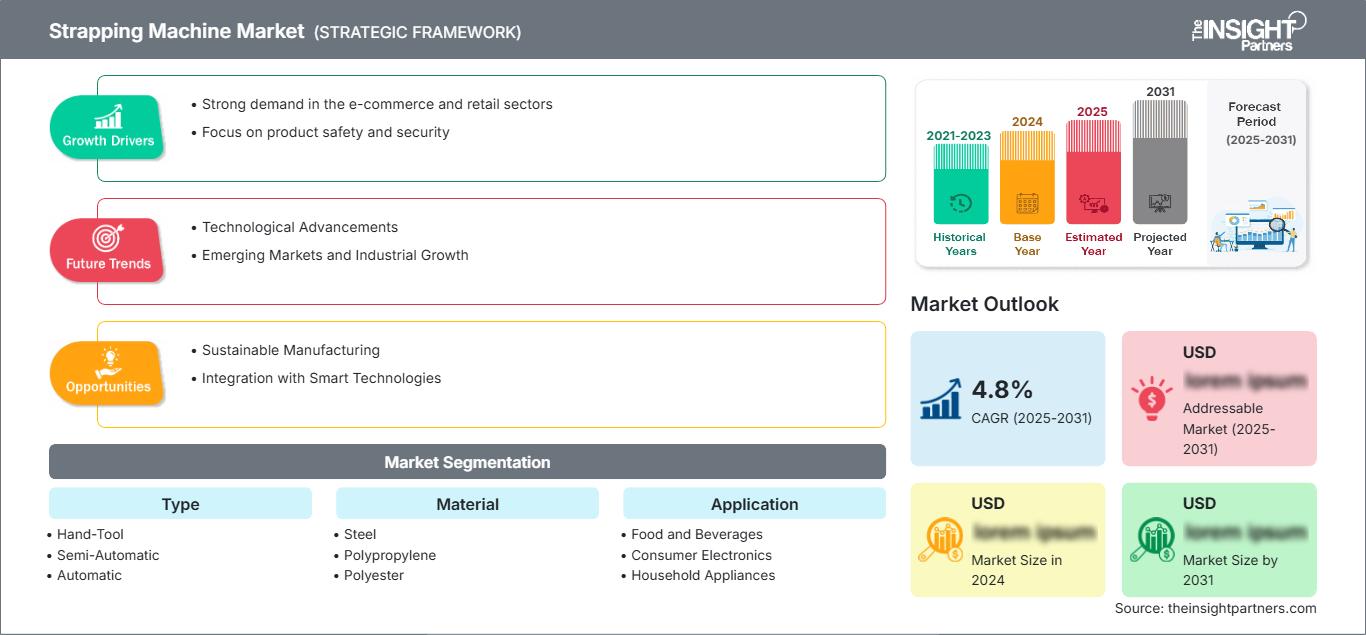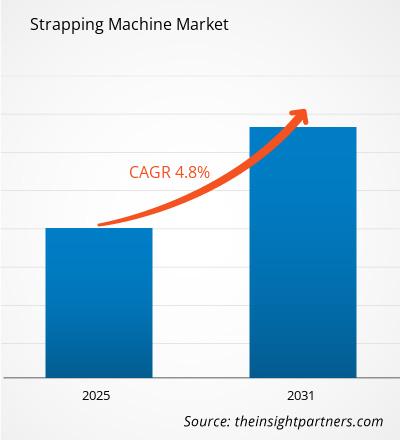Se espera que el mercado de máquinas flejadoras registre una CAGR del 4,8% entre 2025 y 2031, con un tamaño de mercado que se expandirá de US$ XX millones en 2024 a US$ XX millones en 2031.
El informe está segmentado por tipo (herramienta manual, semiautomática, automática). Además, presenta un análisis basado en el material (acero, polipropileno, poliéster). Además, presenta un análisis basado en la aplicación (alimentos y bebidas, electrónica de consumo, electrodomésticos, farmacéutica, periódicos, otros). El análisis global se desglosa por región y por país principal. El informe ofrece el valor en USD para el análisis y los segmentos mencionados.
Propósito del Informe
El informe "Mercado de Máquinas Flejadoras" de The Insight Partners busca describir el panorama actual y el crecimiento futuro, los principales factores impulsores, los desafíos y las oportunidades. Esto proporcionará información a diversas partes interesadas del negocio, como:
- Proveedores/fabricantes de tecnología: Para comprender la dinámica cambiante del mercado y conocer las oportunidades potenciales de crecimiento, lo que les permitirá tomar decisiones estratégicas informadas.
- Inversores: Realizar un análisis exhaustivo de tendencias respecto a la tasa de crecimiento del mercado, las proyecciones financieras del mercado y las oportunidades que existen en toda la cadena de valor.
- Órganos reguladores: Regular las políticas y las actividades policiales en el mercado con el objetivo de minimizar el abuso, preservar la confianza de los inversores y defender la integridad y estabilidad del mercado.
Segmentación del mercado de máquinas flejadoras
Tipo
- Manual de herramientas
- Semiautomático
- Automático
Material
- Acero
- Polipropileno
- Poliéster
Solicitud
- Alimentos y bebidas
- Electrónica de consumo
- Electrodomésticos
- Farmacéutico
- Periódico
- Otros
Geografía
- América del Norte
- Europa
- Asia-Pacífico
- América del Sur y Central
- Oriente Medio y África
Obtendrá personalización en cualquier informe, sin carga, incluidas partes de este informe o análisis a nivel de país, paquete de datos de Excel, así como también grandes ofertas y descuentos para empresas emergentes y universidades.
Mercado de máquinas flejadoras: Perspectivas estratégicas

-
Obtenga las principales tendencias clave del mercado de este informe.Esta muestra GRATUITA incluye análisis de datos, desde tendencias del mercado hasta estimaciones y pronósticos.
Factores que impulsan el crecimiento del mercado de las máquinas flejadoras
- Fuerte demanda en los sectores del comercio electrónico y minorista: Las altas tasas de crecimiento en el comercio electrónico y minorista han impulsado el mercado de las máquinas flejadoras. El auge de las compras en línea incrementa la necesidad de empaquetar y asegurar eficientemente productos en paquetes listos para enviar, lo que impulsa la demanda de máquinas flejadoras.
- Priorizamos la seguridad del producto: Hoy en día, las empresas prestan mucha más atención a la seguridad de sus productos transportados. Las flejadoras ofrecen soluciones robustas para el embalaje, asegurando paquetes y previniendo daños, lo que impulsa el mercado, ya que las empresas buscan un método fiable para garantizar la seguridad de sus mercancías.
Tendencias futuras del mercado de máquinas flejadoras
- Avances tecnológicos: Las tecnologías innovadoras, como la automatización y las máquinas semiautomáticas, que son eficientes y rápidas, ofrecen un amplio margen para la entrada de nuevos productos al mercado. Las empresas que han invertido en I+D para crear nuevos productos tienen mayores posibilidades de captar una mayor cuota de mercado.
- Mercados emergentes y crecimiento industrial: El rápido crecimiento industrial en mercados emergentes como Asia-Pacífico y Latinoamérica ofrece grandes oportunidades en el mercado de las máquinas flejadoras. A medida que estos mercados continúan industrializándose, sus capacidades básicas de fabricación y logística se multiplican, lo que genera una gran necesidad de soluciones de embalaje y flejado adecuadas.
Oportunidades de mercado para máquinas flejadoras
- Fabricación sostenible: Las materias primas también son ecológicas y reciclables en muchas aplicaciones de flejado. Esta es otra tendencia que se está implementando de forma fundamental en la fabricación de máquinas flejadoras. Este es un área con una demanda creciente, dado que las empresas actuales buscan consolidarse con responsabilidad ambiental.
- Integración con tecnologías inteligentes: En este sentido, la integración con tecnologías inteligentes y la automatización es una tendencia creciente en las máquinas flejadoras. Esta integración incluirá conectividad con dispositivos del Internet de las Cosas (IoT), monitorización en tiempo real y análisis de datos, lo que permitirá al fabricante mejorar su eficiencia operativa y reducir el tiempo de inactividad.
Perspectivas regionales del mercado de máquinas flejadoras
Los analistas de The Insight Partners han explicado detalladamente las tendencias regionales y los factores que influyen en el mercado de máquinas flejadoras durante el período de pronóstico. Esta sección también analiza los segmentos y la geografía del mercado de máquinas flejadoras en América del Norte, Europa, Asia Pacífico, Oriente Medio y África, y América del Sur y Central.
Alcance del informe de mercado de máquinas flejadoras
| Atributo del informe | Detalles |
|---|---|
| Tamaño del mercado en 2024 | US$ XX millones |
| Tamaño del mercado en 2031 | US$ XX millones |
| CAGR global (2025-2031) | 4,8% |
| Datos históricos | 2021-2023 |
| Período de pronóstico | 2025-2031 |
| Segmentos cubiertos |
Por tipo
|
| Regiones y países cubiertos |
América del norte
|
| Líderes del mercado y perfiles de empresas clave |
|
Densidad de actores del mercado de máquinas flejadoras: comprensión de su impacto en la dinámica empresarial
El mercado de las máquinas flejadoras está creciendo rápidamente, impulsado por la creciente demanda del usuario final debido a factores como la evolución de las preferencias de los consumidores, los avances tecnológicos y un mayor conocimiento de las ventajas del producto. A medida que aumenta la demanda, las empresas amplían su oferta, innovan para satisfacer las necesidades de los consumidores y aprovechan las tendencias emergentes, lo que impulsa aún más el crecimiento del mercado.

- Obtenga una descripción general de los principales actores clave del mercado de máquinas flejadoras.
Puntos clave de venta
- Cobertura integral: el informe cubre de manera integral el análisis de productos, servicios, tipos y usuarios finales del mercado de máquinas flejadoras, proporcionando un panorama holístico.
- Análisis de expertos: el informe se compila con base en el conocimiento profundo de expertos y analistas de la industria.
- Información actualizada: El informe asegura relevancia comercial debido a su cobertura de información reciente y tendencias de datos.
- Opciones de personalización: este informe se puede personalizar para satisfacer los requisitos específicos del cliente y adaptarse adecuadamente a las estrategias comerciales.
Por lo tanto, el informe de investigación sobre el mercado de máquinas flejadoras puede ayudar a descifrar y comprender el panorama de la industria y sus perspectivas de crecimiento. Si bien existen algunas preocupaciones válidas, las ventajas generales de este informe suelen superar las desventajas.
- Análisis histórico (2 años), año base, pronóstico (7 años) con CAGR
- Análisis PEST y FODA
- Tamaño del mercado, valor/volumen: global, regional y nacional
- Industria y panorama competitivo
- Conjunto de datos de Excel
Informes recientes
Informes relacionados
Testimonios
Razón para comprar
- Toma de decisiones informada
- Comprensión de la dinámica del mercado
- Análisis competitivo
- Información sobre clientes
- Pronósticos del mercado
- Mitigación de riesgos
- Planificación estratégica
- Justificación de la inversión
- Identificación de mercados emergentes
- Mejora de las estrategias de marketing
- Impulso de la eficiencia operativa
- Alineación con las tendencias regulatorias






















 Obtenga una muestra gratuita para - Mercado de máquinas flejadoras
Obtenga una muestra gratuita para - Mercado de máquinas flejadoras